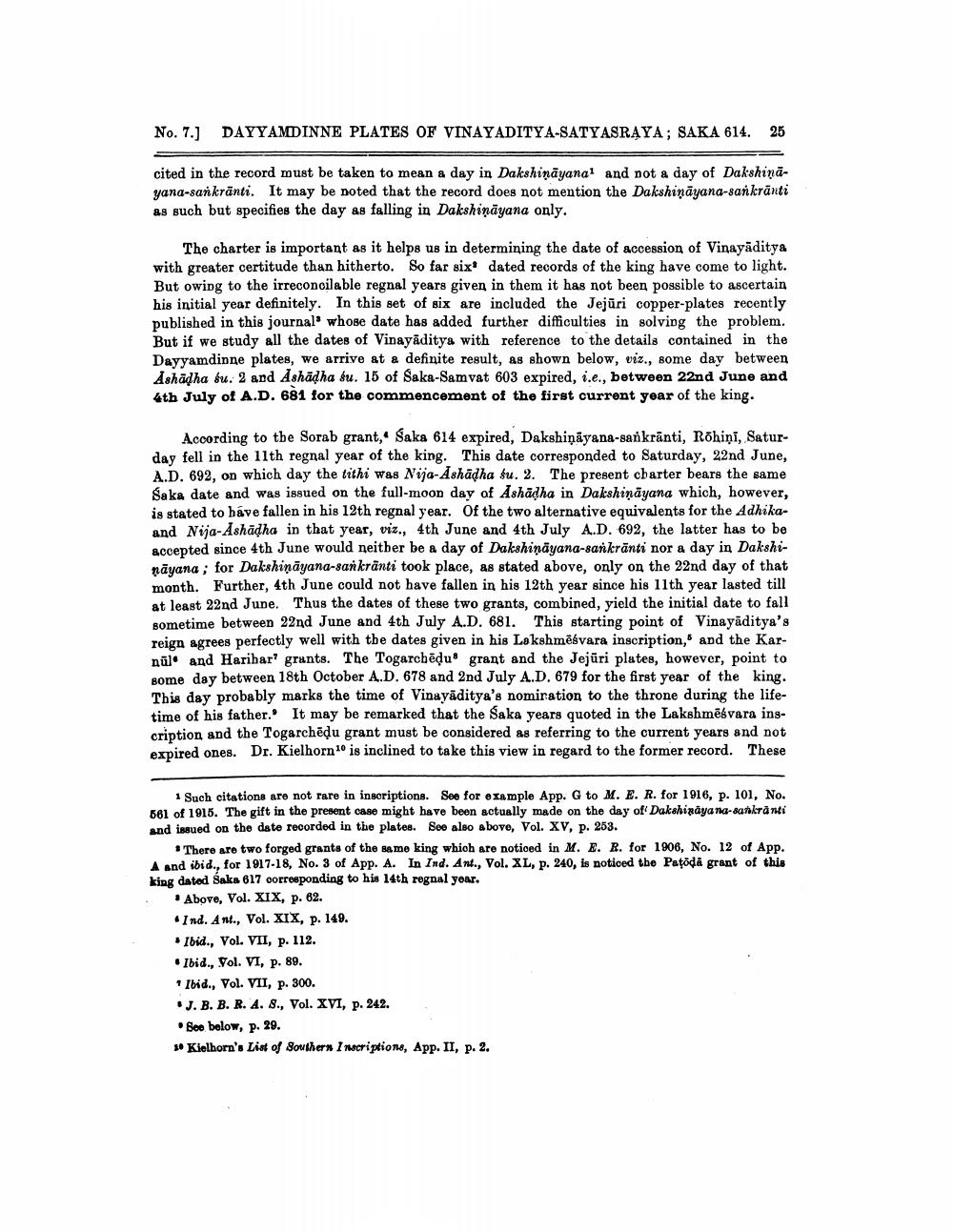________________
No. 7.) DAYYAMDINNE PLATES OF VINAYADITYA-SATYASRAYA; SAKA 614.25
cited in the record must be taken to mean a day in Dakshināyanal and not a day of Dakshinayana-sankrānti. It may be noted that the record does not mention the Dakshiņāyana-sankrānti as such but specifies the day as falling in Dakshiņāyana only.
The charter is important as it helps us in determining the date of accession of Vinayāditya with greater certitude than hitherto. So far six dated records of the king have come to light. But owing to the irreconcilable regnal years given in them it has not been possible to ascertain his initial year definitely. In this set of six are included the Jejūri copper-plates recently published in this journal' whose date has added further difficulties in solving the problem. But if we study all the dates of Vinayāditya with reference to the details contained in the Dayyamdinne plates, we arrive at a definite result, as shown below, viz., some day between Ashādha šu. 2 and Ashādha bu. 15 of Saka-Samvat 603 expired, i.e., between 22nd June and 4th July of A.D. 681 for the commencement of the first current year of the king.
According to the Sorab grant, Saka 614 expired, Dakshiņāyana-sankranti, Rõhiņi, Saturday fell in the 11th regnal year of the king. This date corresponded to Saturday, 22nd June, A.D. 692, on which day the tithi was Nija-Ashādha tu. 2. The present charter bears the same Saka date and was issued on the full-moon day of Ashādha in Dakshināyana which, however, is stated to háve fallen in his 12th regnal year. Of the two alternative equivalents for the Adhikaand Nija-Ashādha in that year, viz., 4th June and 4th July A.D. 692, the latter has to be accepted since 4th June would neither be a day of Dakshinayana-sankrānti nor a day in Dakshināyana ; for Dakshināyana-sankranti took place, as stated above, only on the 22nd day of that month. Further, 4th June could not have fallen in his 12th year since his 11th year lasted till at least 22nd June. Thus the dates of these two grants, combined, yield the initial date to fall sometime between 22nd June and 4th July A.D. 681. This starting point of Vinayāditya's reign agrees perfectly well with the dates given in his Lakshmēsvara inscription, and the Karnūlo and Harihar? grunts. The Togarcbēdu grant and the Jejūri plates, however, point to some day between 18th October A.D. 678 and 2nd July A.D. 679 for the first year of the king. This day probably marks the time of Vinayāditya's nomination to the throne during the lifetime of his father. It may be remarked that the Saka years quoted in the Lakshmēsvara ingcription and the Togarchēdu grant must be considered as referring to the current years and not expired ones. Dr. Kielhorn is inclined to take this view in regard to the former record. These
1 Such citations are not rare in inscriptions. See for example App. G to M. E. R. for 1916, p. 101, No. 661 of 1915. The gift in the present case might have been actually made on the day of Dakshinayana-sankranti and issued on the date recorded in the plates. See also abovo, Vol. XV, P. 253.
There are two forged grants of the same king which are noticed in M. E. R. for 1906, No. 12 of App. Aand ibid., for 1917-18, No. 3 of App. A. In Ind. Ant., Vol. XL, p. 240, is noticed the Patödå grant of this king dated Saka 617 corresponding to his 14th regnal year.
Above, Vol. XIX, p. 62. *Ind. A nt., Vol. XIX, p. 149.
Ibid., Vol. VII, p. 112. . Ibid., Vol. VI, p. 89. * Ibid., Vol. VII, p. 300.
J. B. B. R. A. 8., Vol. XVI, p. 242.
Soo below, p. 29. ** Kielhorn's List of Southern Inscriptions, App. II, p. 2.




